Part of me feels like Lehigh Gorge Scenic is hinting at something with this post

Saw this pretty girl playing second fiddle on her way through Newark DE this morning:

Quick search says that paint is about 2 months old.
The one on the bottom left is Lehigh Gorge Scenic Railway SD50 #426. After Reading & Northern took over the trips out of Jim Thorpe from George Hart and started the Lehigh Gorge Scenic Railway, they had the blue-painted coaches to go with the blue-painted steam locomotive (contrary to popular belief, the blue was chosen to emulate the Reading Crusader, not the CNJ Blue Comet), so they took a Reading & Northern ex-MoPac SD50, renumbered it from #5033 to #426, and painted it in the same blue with the Lehigh Gorge Scenic Railway logo on it. The repaint was done in 2009, and it ran in those numbers until 2016, at which point it returned to #5033 and was put back into the freight pool, and then in 2018 it was repainted back into the R&N gray, yellow and green livery that they used on the SD50s. It was then parked in the dead lines up at Mountain Top a couple years later and has not run since.

I gotta be honest, I can't imagine they're bringing back the #426. They've moved largely away from the blue paint over the past few years. The #426 was bumped off of LGSR service when they bought the GP39RNs to take over the passenger end of things and painted the two of them in maroon and yellow and began painting most of the passenger cars to maroon as well (and the GP39RNs have since been bumped by the GP38s in Reading green and yellow). They've also moved away from the old ex-MoPac/UP SD50s as a whole; the CSX SD50s were derated to SD40-2 specs and are still running about, but the UP SD50s retained the full 3500hp output and were more troublesome. In fact, R&N had put all the ex-UP SD50s up for sale, last I'd heard.
Duke said:Saw this pretty girl playing second fiddle on her way through Newark DE this morning:
Quick search says that paint is about 2 months old.
Oooh, lucky you. That's the one I want to catch, out of the CSX heritage units. It rolled through here on July 4th, but I was busy and didn't find out until after it had passed through anways.
The #5033, before it became #426, up to Steamtown on display in 2005, along with Canadian Pacific GP40-2 #4654, ex-D&H GP38-2 #7312 Bernie O'Brien, the #5033, and Delaware-Lackawanna M636 #3643.

NickD said:Hickory Creek and Tavern-Lounge #43 are certainly going to be busy next month, since they are headed out to Chicago on the tail end of the Lake Shore Limited on September 17th to commemorate the 75th anniversary of the redesigned 20th Century Limited, which those cars were used on. They then are coming back for use on the NJT 40th Anniversary Express. I also have a suspicion that on the week in between, on their way back east, they're going to be used by Fort Wayne Railroad Historical Society for a weekend. FWRHS posted a clip from the old NYC promotional film "New York Calling" last night with the caption of "Something special is arriving soon..." There's all these people saying that they're bringing #765 east for a 40th anniversary excursion on Metro North or that FWRHS is buying one of the two NYC Mohawks to restore, but I think they're pretty far offbase. Really confirming my theory is that URHS of NJ commented on the same post saying "This is going to be so good."
Well, I was also not correct with my theory either, but I was kind of close. Last night, Fort Wayne Railroad Historical Society made their big announcement, and it did involve NYC passenger cars. They have purchased the seven remaining Budd stainless-steel cars that were built for the 1941 relaunch of the Empire State Express. The seven cars had been preserved at the Rochester & Genesee Valley Railroad Museum and had been used by the museum for the occasional off-property excursion on the Lakeville, Avon & Livonia through the '90s and early '00s, but hadn't done that for quite some time.
The seven cars are:
Six of the cars from the fleet were acquired by the Rochester Chapter of the National Railway Historical Society in 1987 and made part of their growing museum collection where it was later joined by a railway post office car to complete the set. According to Kelly Lynch, Vice President of the Fort Wayne Railroad Historical Society, two of the cars had been "tunneled" in hopes of converting them back to an original configuration by the volunteers at the R&GVRM, and are prime candidates to turn into something resembling/inspired by the lounge, dining, or parlor cars of the original New York Central designs.
A breakdown of the full plans is posted at https://www.greatsteelfleet.org/empire-state-express/
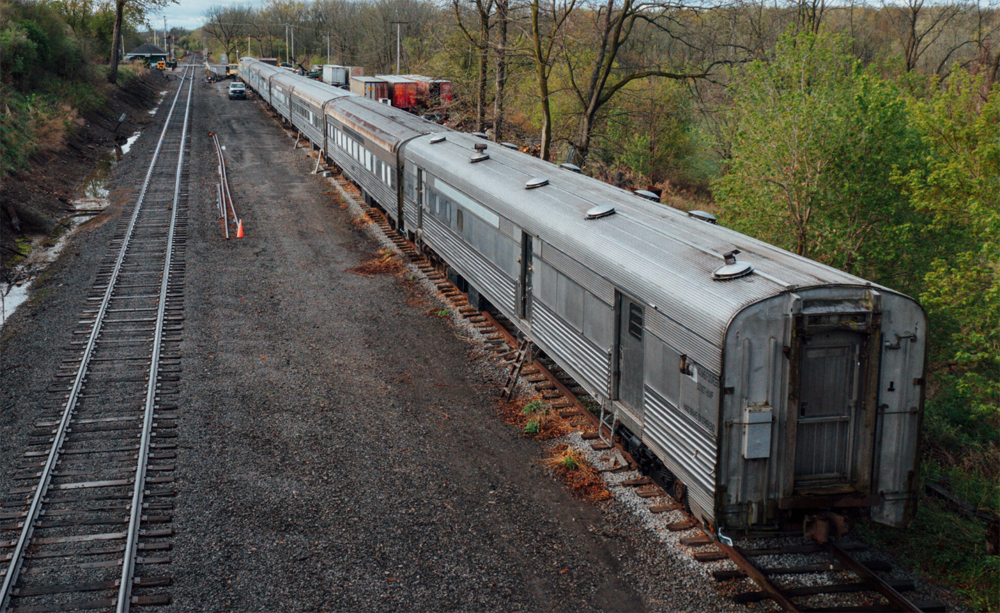
A photo of the inaugural run of the 1941 iteration of the Empire State Express, which had the misfortune of debuting on December 7th, 1941. The train was pulled by a stainless-steel shrouded J-3a Hudson, with the streamlining designed by Chase H. Knowlton and George M. Davies. While there is a resemblance to the Henry Dreyfuss-styled Hudsons used on the 20th Century Limited, Dreyfuss was not involved with the project. The train was distinctively the most limited in stops (aside from the even more elite 20th Century Limited) in the New York City to Albany section. Beyond 125th Street, it only made a stop at Croton-Harmon, the location for switching from electric to steam/diesel power, and made no other stops until Albany.

The cars have already been moved by the Lakeville, Avon & Livonia behind Alco C430 #433 and C425 #428 from the R&GVRM over the LA&L (which runs on an ex-West Shore Line branch) to the CSX interchange at Genesee Junction for movement to Fort Wayne. These will add to a captive fleet of passenger cars for FWRHS, which will reduce the need to try and source passenger cars anytime they want to run excursions. As Kelly Lynch put it "Both FWRHS and Virginia Museum of Transportation are in similar boats: regional railroads to run on in their "backyard" but little serviceable cars at their immediate disposal. A wild challenge to have two of the hardest parts of the equation (locomotive + railroad) but not have the seats, made only slightly more ironic as FWRHS had its own fleet 35 years ago."



Fort Wayne Railroad Historical Society has also acquired the 141 year old ex-New York Central/Lake Shore & Michigan Southern depot in Pleasant Lake, Indiana (where I caught #765 storming by last year) The station will host the upcoming Tails & Rails Train, Cigar Train, Indiana Fall Color Trains, and the Indiana Christmas Train. Though the station’s interior is largely preserved, improvements will likely include a new platform, lighting fixtures, and other amenities. Plans call for the structure and nearby property to receive cosmetic and structural improvements over the next year to host train rides and community events.

Today, 51 years ago, Hurricane Agnes passed through Pennsylvania and New York and pretty much annihilated the northeastern railroads.

This photo shows Canadian National 2-6-0 #89 emerging from the floodwaters in Wilkes-Barre, PA after the storm ripped through. The Mogul had been en route to Strasburg Rail Road, having just been purchased from Steamtown USA/Green Mountain Railway in Bellows Falls, VT, and was being run down under it's own power by Strasburg crews. They stopped for the night in Wilkes-Barre when the storm hit, and ended up retreating to the second story of the firehouse in the background as the waters continued to rise. At it's peak, the water was three feet above the smokestack on the #89. By the next morning, the waters had receded and Linn Moedinger stripped off his shirt and waded over to the #89 for this pic. Up until this point, the #89 was on track (har-har) to be just the second steam locomotive to arrive at Strasburg under it's own power (Reading 0-4-0 Camelback #1187 was the other) but after being submerged, it was eventually towed cold there, since the thing was chock full of mud. From what Kelly Anderson said, decades later when the #89 was undergoing major repairs, they were still finding mud packed in the damndest places as a result of the submersion.
Hurrican Agnes, or Tropical Storm Agnes as it had been demoted to by the time it hit NY and PA, could not have hit a worse area at a worse time. By that point, Penn Central had been bankrupt for two years and wasn't getting any better, PC was dragging down the Lehigh & Hudson River and the Lehigh Valley, things weren't exactly rosy over at the Reading, and Erie-Lackawanna was finally starting to claw it's way in to profitability. Along came Agnes, blowing back inland and then getting stalled out over western NY and PA, and dumped up to 12" of rain an hour into the Susquehanna and Conowingo Rivers, and that pretty much put the northeastern lines over the edge.
Penn Central had over 1500 washouts over the eastern end of their system. The southern end of the Northern Central line was pretty much completely wiped out by flooding, and the bankrupt PC decided not to repair the historic line. This also severed the Stewartstown Railroad's link to the outside world as well, and they had a GE 44-tonner that was in the process of being delivered when Agnes hit that would take 12 years until it actually arrive at the Stewartstown. The formerly PRR Wilkes-Barre Branch line to Sunbury was also washed out, which would have cut Penn Central interchange to the D&H, and it took the D&H petitioning to the ICC for Penn Central to restore it to operation. At Corning, NY, the ex-New York Central bridge had loaded coal cars parked on top of it in advance, in the hopes they would stabilize the bridge, but it was wiped out, along with 24 other PC bridges, and another 23 that were damaged. The west end of the PRR Octoraro Branch was also pretty damaged, in particular west of Chadds Ford, with stranded cars being craned out to the Reading's W&N line at the junction site. Further lines that were damaged included from Bedford, PA to Cumberland, MD, the Waynesboro, PA branch, and the Dillsburg, PA branch. The Frederick,MD. branch was cut at the Monocacy River north of town, when the bridge lost 2 girder sections and 1 pier, and would remain out of service until 25 years later the Walkersville Southern repaired the bridge. The entire PRR Elmira Branch, from Elmira north to Sodus Point, NY was also wiped out and abandoned. With Penn Central in poor financial condition beforehand, they were unable to repair a lot of these branches, nor did they really desire to restore many of them, and they used Agnes as a way to rid themselves of them. The entire Port Road was also almost completely submerged, and I've read accounts from engineer's saying that their E44s ground to a halt when the traction motors shorted out, and they were told to tie down the train, and hike up the bank where a company van would pick them up and take them home. Perhaps the strangest was the Chester Creek Secondary, which washed out between Wawa and Lamokin and was never restored. It was conveyed to Conrail in 1976, even with no track, because it was the route of a major connector in the power grid.
Erie-Lackawanna had actually been on the verge of a comeback in 1971 and early 1972. Working hand in hand with the D&H under N&W's DERECO stewardship had smoothed out interchange traffic, Amtrak had removed their passenger obligations, and New Jersey DOT had stepped in to subsidize their NJ commuter operations and slowed the bleeding there. E-L's ex-Erie line across the Southern Tier avoided most major population centers, and while it wasn't great for on-line customers, it made for a helluva express freight route, and E-L was wheeling piggybacks and containers and auto-racks east and west with a vengeance. In fact, the government was already working on what would become Conrail, and was going to leave E-L out to function as the competitor to Conrail, since it had a lot of the same destinations and was financially improving. Then Agnes came along and pretty much every RR bridge in the Poconos was blown out and the Southern Tier Line was clobbered with over 100 washouts from Hornell to Owego, with over 130 miles of trackage out of service. Erie-Lackawanna was forced to make all sorts of weird rerouted freight moves, with stuff coming in from the west through Detroit and Canada over the Canadian Pacific and then hopping on the old New York Central mainline to Syracuse, then taking the former DL&W line from Syracuse south to Binghamton. They were also routing freights on CP as far east as Montreal and then running them down the D&H, which was relatively unscathed by Agnes. Just two days after Agnes passed through, the E-L filed for bankruptcy and petitioned for inclusion in Conrail.
Less effected, but effected nonetheless were the Lehigh Valley and Reading. Lehigh Valley's big bridge over the Chemung River at Athens, PA had a center pier that was damaged by floodwaters. Lehigh Valley never had the money to repair it, and Conrail never had the desire to repair it, and current operator Lehigh Railway has also never repaired it either. LV's Mountain Cutoff between Mountaintop, PA and Coxton Yard in Pittston also was washed out, but was repaired in fairly short order. Still, LV was in pretty bad shape, and just two years after filed for liquidation. The Reading, which was still solvent at the time, lost a portion of the Perkiomen Branch, never to be rebuilt. They had also routed traffic from Philadelpha and points south to Buffaloa and Canada via an EL interchange at Rupert (near Catawissa), which had increased traffic on the west side of the Susquehanna River. One of the RDG-EL joint moves ended up stranded by flooding, and sat in a small yard at Berwick for several days. The damage to the Reading also caused the Reading to file for bankruptcy and petition for inclusion into Conrail.


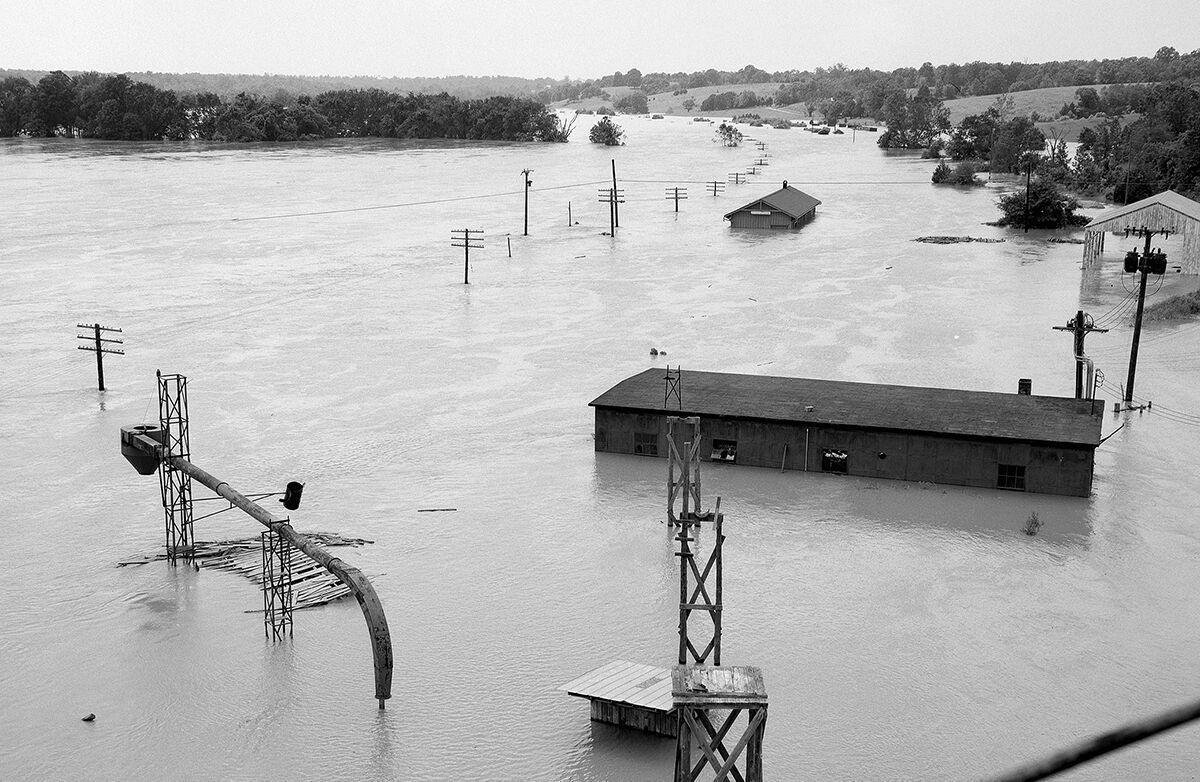


In reply to NickD :
I lived in SEPA at the time, and Agnes's eye went right over my house. It was devastating. I lived on a hillside over a small farming valley with a creek running throughn the floor. In 24 hours that storm substantially and permanently altered the landscape of that little valley.
The Penn Central bridge at Corning, NY as the water rose under it. You can see the loaded coal cars parked on it, in an attempt to stabilize the bridge.

And the aftermath. That's the big Corning glass works behind the bridge on the left. If you're ever in the area, I highly recommend the Corning Museum of Glass. Just a warning, you will not see the entire museum in a day, it's simply not feasible.




PRR's big Shocks Mills Bridge, constructed in January 1905 for the Atglen and Susquehanna Branch of the Pennsylvania Railroad, also lost 9 piers during the Agnes flooding. Penn Central's commuter train service between Lancaster and Harrisburg was affected by the damages to the bridge, and freight traffic to Harrisburg was required to be re-routed. The federal bankruptcy court, overseeing the reorganization of Penn Central, gave the railroad permission to make repairs to the span, and PC installed steel girder spans in the site of the washed out section. The bridge is still active under Norfolk Southern, although much of the A&S Branch south of Columbia is no longer active.

The Wellsville, Addison & Galeton was another railroad who's end began with Agnes. The WA&G, typically referred to as "The Wag", had begun life as a segment of the Buffalo & Susquehanna Railroad, a once-proud company that had slid into a somewhat diminished existence by the time that the Baltimore & Ohio took it over in 1932. David Page Morgan recounted visiting the B&S in the B&O era and accidentally upsetting a greybeard employee when he mentioned how quaint it was, and the employee began recounting when it had a full roundhouse, 200 employees, Pullman and sleeper car service, and an RPO contract. In 1942, a flood severed a V-shaped segment of the line from the B&O system, one running northwest to Wellsville, NY, where it connected to the Erie Railroad, and the the other running northeast to Addison, New York and also connected to the Erie, along with with one short segment running east to Ansonia, PA and a connection with the New York Central, and another segment running southwest to Burrows, representing the stub end of the former connection to the B&O. B&O continued operating this weird, remote 91-mile of trackage, completely disconnected from their own network, until 1956, using 6 handsome E-60 Consolidations.
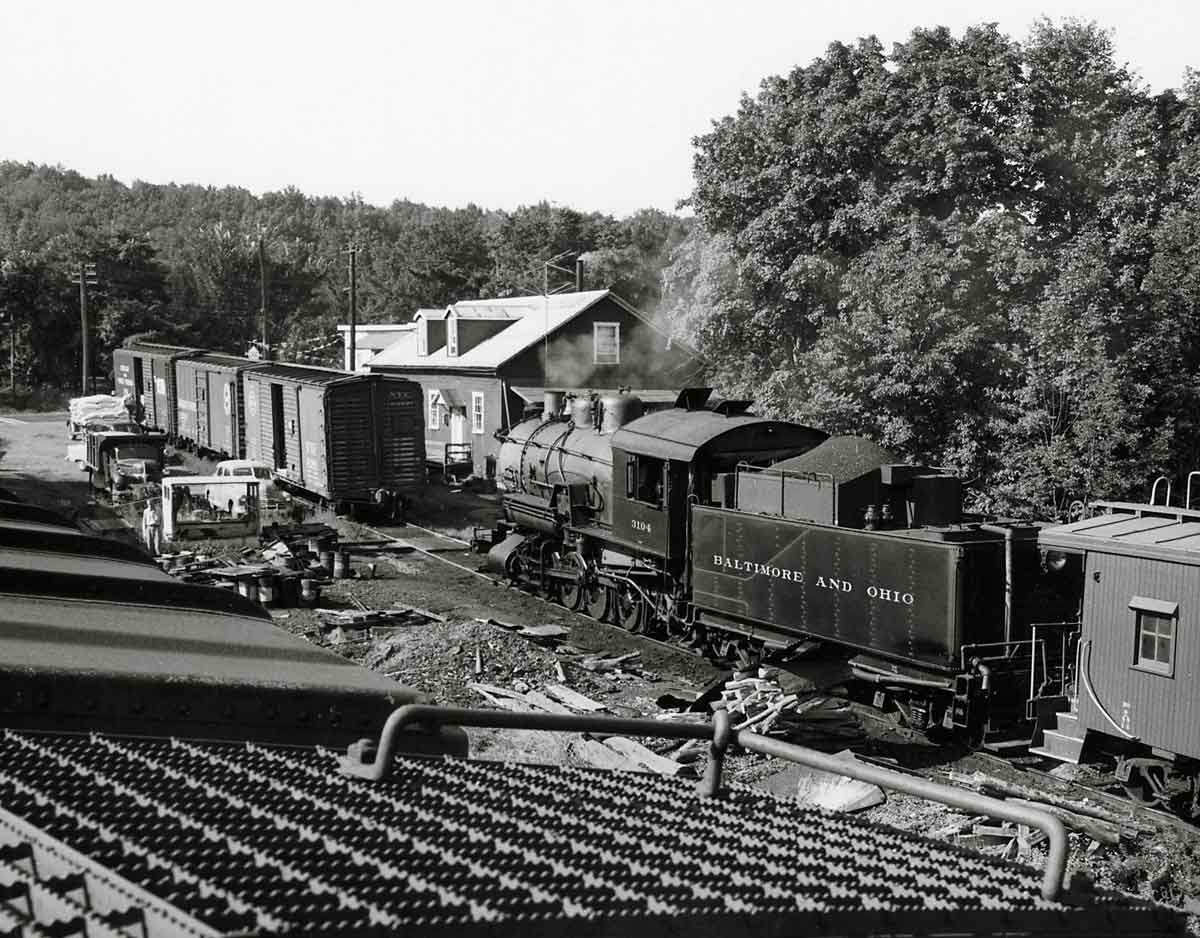
In 1956, the B&O sold off the line for $250,000, including six ex-B&S steam locomotives, four cabooses, and a miscellany of work equipment, to the H.E. Salzberg Company, which operated a number of other short lines. Operations of the Wellsville, Addison & Galeton began in 1956, with the intent to dieselize immediately. The first diesels, a pair of Whitcomb 75-tonners, were found to be inadequate, and so the steam locomotives were briefly used, until the Wag purchased a pair of 125-ton GE centercabs previously used at the Ford Motor Company plant, followed by another five 132-ton GE centercabs also of previous FoMoCo ownership. Major customers included a Sinclair refinery at Wellsville and tanneries in Elkland and Westfield, the latter supplying the nickname of "The Sole Leather Line", which was painted on some equipment.
The washed-out Burrows branch was abandoned soon after WA&G began operations, and the Elkland-Addison portion followed in 1960. In 1964 the line expanded to include the Coudersport & Port Allegany Railroad, which crossed at Newfield Junction on the Wellsville line. Starting in 1968, the ex-Ford GEs, who's reliability had become extremely suspect, were phased out and H.E. Salzberg Company bought a bunch of ex-SP and ex-WP EMD F7s that had been traded into GE. Two of the F7s stayed at "the Wag", while the others went down to the Louisiana & North Western, another Salzberg line. The GEs would occasionally be used, but very erratically. Like a number of short lines in the late 1950s, the WA&G made a profitable business out of leasing cars in interchange service. This began with a purchase of 78 wooden boxcars, and eventually grew to 761 car in service. These cars grew less profitable through the years though, and the refusal of Penn Central to renew a lease of 300 wooden cars put an end to their use, though a number of metal-sided cars remained in service.
When Agnes hit the northeast in 1972, WA&G was reduced to a weed-strewn, decrepit, erratically-operating 40-mile operation between Galeton to Elkland, with a branch (and its only outside connection, with the Penn Central) to Ansonia. A fire destroyed the Elkland tannery in 1973, wiping out a huge chunk of it's business. It also threw in the towel on the C&PA trackage and abandoned that around the same time. More floods further damaged the railroad, and finally the Salzberg Company said enough was enough and filed for abandonment in 1975. Approval to abandon was granted by the ICC in 1978, and the final freight ran on March 13, 1979. The line remained open until November to retrieve equipment and ship locomotives to various buyers.
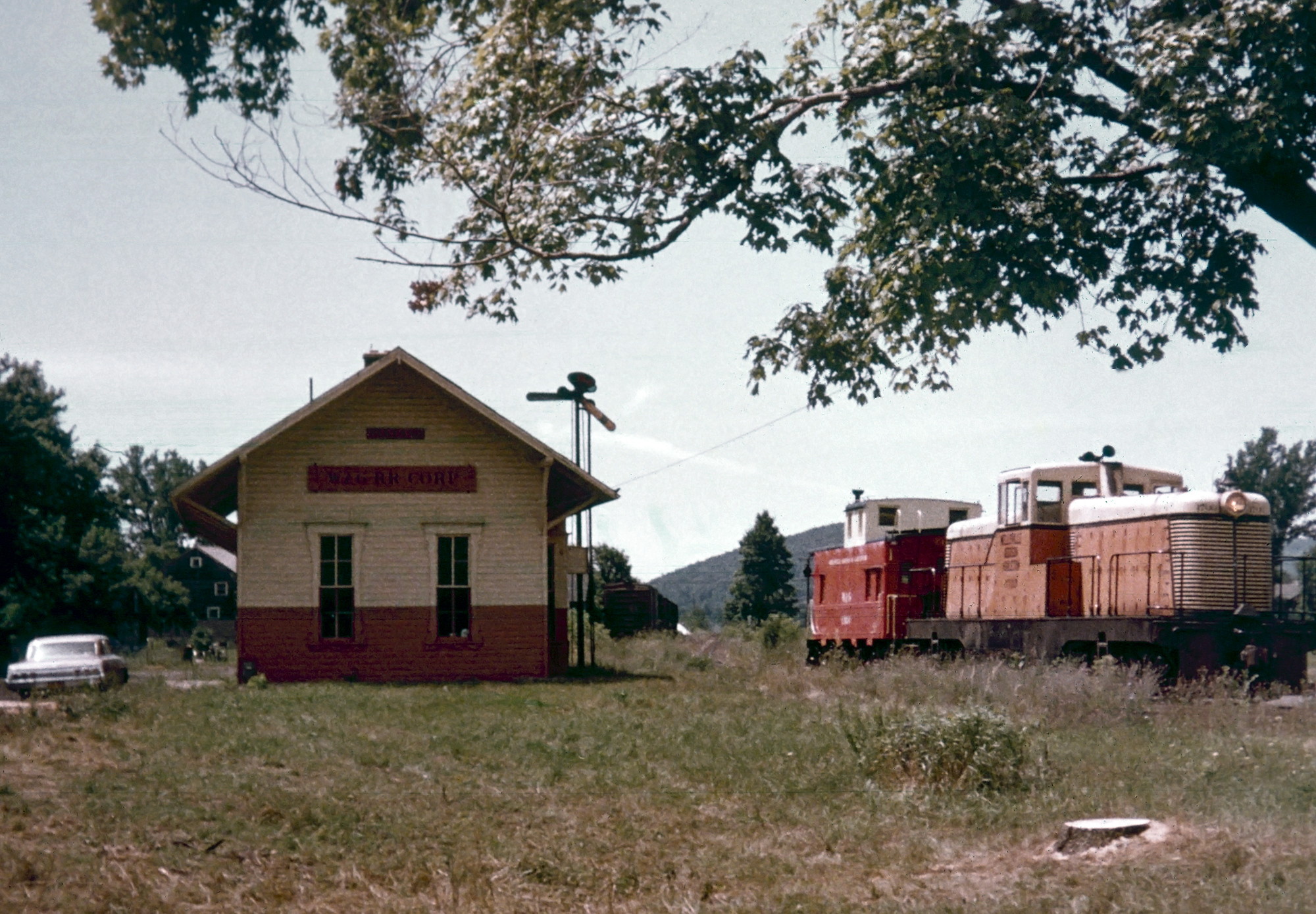

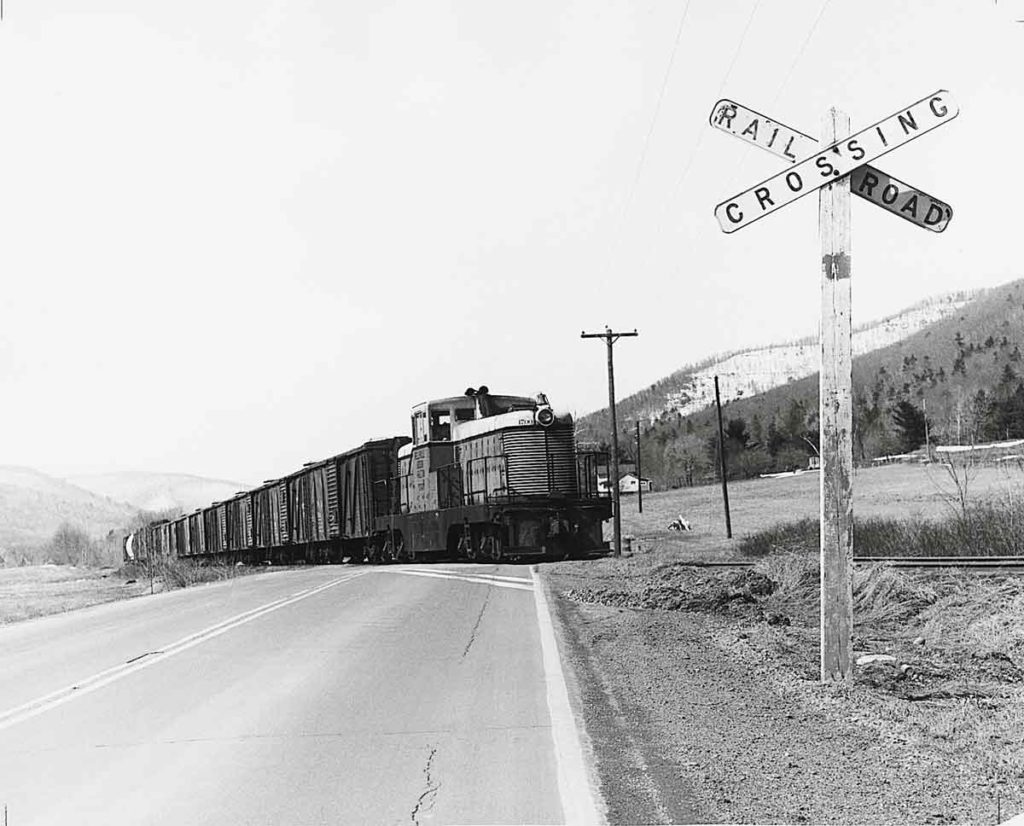
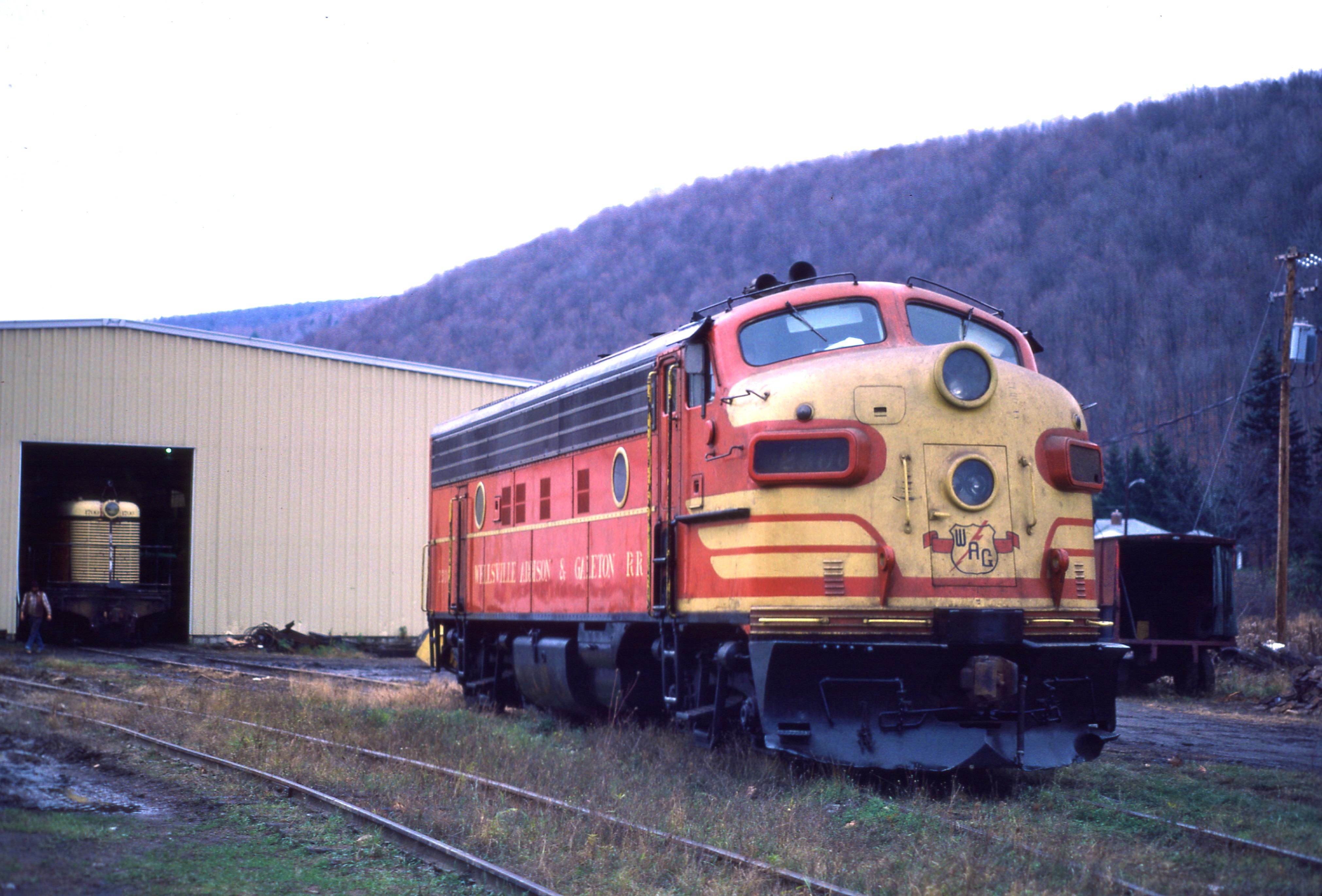
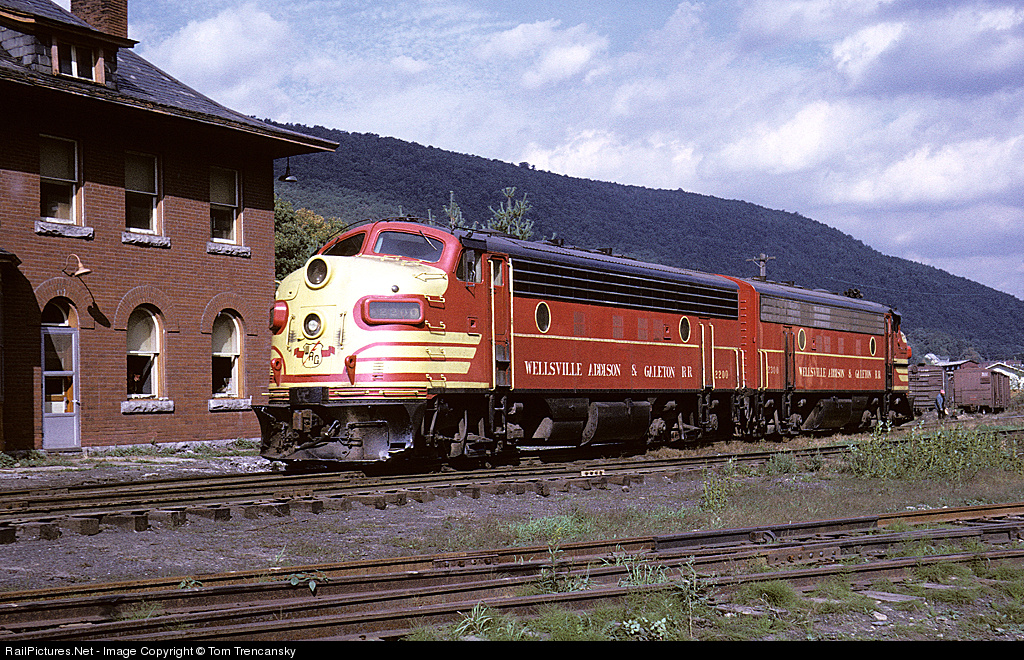
One of the ex-Ford WA&G GEs operating at a rather late date. Ford Motor Company had special-ordered the 125- and 132-tonners from GE with styling flourishes to make them less utilitarian than most GE products of the era. This included curved, chromed handrails and the stylized grilles at the end that were intended to evoke styling cues of Ford trucks of the era. Fortunately, while not much remains of the WA&G (the rails are all gone and floods and fires have essentially obliterated the right of way), the #1700 is preserved at the Lake Shore Railway Museum in North East, PA, not far from the Erie, PA plant where it was produced.

In a roundabout way, Agnes also led to the D&H's eventual downfall, albeit in a roundabout way. The D&H itself took relatively little damage from the storm itself, and E-L was running detoured trains through Canada on CP and then down the D&H to southern NY and Pennsylvania because the D&H mainline was still active.
In 1970, Penn Central had gone bankrupt, the largest corporate bankruptcy of the time, and Union Pacific, who had 25% of their traffic originating from interchange with the northeast, became alarmed by how rapidly the situation was deteriorating. UP voiced their concerns to the ICC, and the federal government began working on a plan to restabilize the northeast. At the outset, the railroads involved were primarily Penn Central and Lehigh Valley. The CNJ was not healthy and really hadn't been in years but was mostly superfluous trackage, the Reading Company was hanging in there, Norfolk & Western had taken control of the D&H (which was fairly healthy) and the Erie-Lackawanna (decidedly less healthy) through DERECO, and the Lehigh & Hudson River was struggling but still alive (the burning of Poughkeepsie Bridge in '74 slit their throat). The revived USRA had begun work on what would eventually become Consolidated Rail Corporation.
The big issue was that the government needed a competitor to what would become Conrail, so that Conrail didn't have a government-created monopoly on traffic in the northeast. By 1972, the Erie-Lackawanna, under N&W's stewardship, was starting to show signs of being sustainable, and it had the big east-west routing of Chicago-New York that Conrail would get from Penn Central. The E-L actually had far better NYC-Chicago service than PC, and while that was not hard to do in that time frame, CSX and NS have a roughly 28-30 hour run today, and E-L's premier freight train, CX-99, ran a 27.5 hour schedule and before Agnes it was pretty much on time all the time. PC did have lines down to St. Louis and Kentucky that E-L didn't have but that likely could have been solved by giving Erie-Lackawanna trackag rights over either Conrail or Norfolk & Western's ex-Wabash and ex-NKP lines. And E-L, via Maybrook Yard and the D&H, had connections to New England lines.
Then came Agnes, and two days later the E-L was bankrupt and petitioning to be included into Conrail, which sent the ICC/USRA scrambling to find a new solution. They settled on handing over the eastern end of the Erie-Lackawanna, the Reading (also insolvent thanks to Agnes) and the CNJ (pretty much insolvent since the end of WWII) over to Chessie Systems. It would help Chessie Systems crack into the NY, NJ and PA markets, there was already a history there among the companies because B&O had owned part of Reading who owned part of CNJ and Western Maryland had mutual trackage rights with the Reading, and Chessie System had a better route out to Chicago through both C&O and B&O, as well as lines down into Virginia, Kentucky, and Missouri. The big issue there was that E-L had some serious issues with union featherbedding, which had long been an operational drain on it. While everyone else was moving to three-man crews, E-L's unions still required 5-man crews over the entire system, and 6-man crews through Ohio. CNJ and Reading also had some of the same union agreements, and Chessie System was not enthused about it, so they said they would only take on the deal if E-L, CNJ and Reading took C&O's union agreements. Employees of all three railroads balked at that, and so Chessie offered the slightly more onerous (to the C&O at least) B&O union agreements, since E-L, CNJ and Reading all connected to the B&O and it seemed like a natural extension of unions and an olive branch from Chessie Systems. CNJ and Reading were willing to go in, but E-L refused to even consider the offer. The government gambled, incorrectly, that it would be easier to force Chessie Systems to bow to the union demands than it would be to force the unions to accept Chessie Systems' terms. At the eleventh hour, Chessie Systems walked on the deal, since they refused to saddle themselves down with E-L's labor agreements and knew that if the E-L workforce quit, they couldn't replace them in a timely fashion.
Reportedly there was a proposal by Atchison, Topeka & Santa Fe sometime in 1975 to acquire the entirety of the Erie-Lackawanna, along with the Toledo, Peoria & Western and the somewhat obscure Eel River Railroad. The idea was that it would give Conrail an eastern competitor, by preserving the E-L's lines, as well as making the ATSF a true Atlantic-to-Pacific transcontinental railroad, with the TP&W and Eel River helping smooth out some of the connections. There were some in-depth studies performed by ATSF but it never went any further and I've heard separate theories why. One, was that ATSF took a look at E-L's infrastructure and finances, which had slipped from acceptable to truly bad, and figured it wasn't worth the time, effort, and money that it would take to buy the railroad out and then rehabilitate it to ATSF standards. The other is that the federal government actively discouraged ATSF from going through with the plan, because they were worried that ATSF being able to run traffic all the way to NY/NJ on their own rails would deprive Conrail of a huge chunk of interchange traffic and lead to Conrail's failure. Both seem plausible, they might be true, they might not. Either way, it never happened.
This all led to the very last-minute, thrown-together proposal to make D&H the Conrail competitor, which was flawed beyond belief. It turned the D&H from profitable to losing massive amounts of money in two years, leading to N&W selling it off to Guilford, who raped and pillaged and bankrupted the D&H, which then led to it's buyout by Canadian Pacific that resulted in the D&H basically vanishing.
As for the E-L itself, most of the line west of Buffalo was abandoned. It was originally sold off to the Erie Western Railroad, a shortline formed to preserve the Indiana portion of the west end of the E-L, with trackage rights into Illinois on the Chicago & Western Indiana Railroad, but that lasted all of two years before it became apparent that operating that portion of the line was truly untenable. The Chicago & Indiana Railroad tried taking over on June 24th, 1979 and ended operations even more rapidly, closing up on December 31st, 1979. The majority of the west end was ripped up shortly afterwards. A lot of the old DL&W on the eastern end of the E-L is either abandoned or dormant, with NYS&W ending up with a fair bit, and the old Erie Southern Tier Line is also mostly quiet these days, although still technically active under Norfolk Southern.
One of the Erie Western's ex-C&NW RS-3s at Griffith, Indiana shortly after startup. Conrail was buying or leasing anything with an EMD 567 that ran, and so a lot of these shortlines that sprung up to take over castoff bits of pre-Conrail trackage were forced to buy up oddball power. For the Erie Western, that was four ex-C&NW Alco RS-3s and two ex-Long Island Rail Road high-hood, long hood forward, steam generator-equipped Alco C420s.

In reply to 02Pilot :
Yeah, that's a neat little engine. Originally when I first saw headlines of that engine being fired up on the Albany & Eastern, my mind jumped towards it being some little obscure shortline in Albany, NY. I was disappointed to discover that it was in fact an Albany that was about as far away as you could get while still being in the contiguous United States. Every once in a while, Everett Railroad will use the #11 for actual revenue freight, and I know on rare occasions Strasburg will send #90 down to the Leaman Place to pick up the freight that NS has dropped off.
You'll need to log in to post.